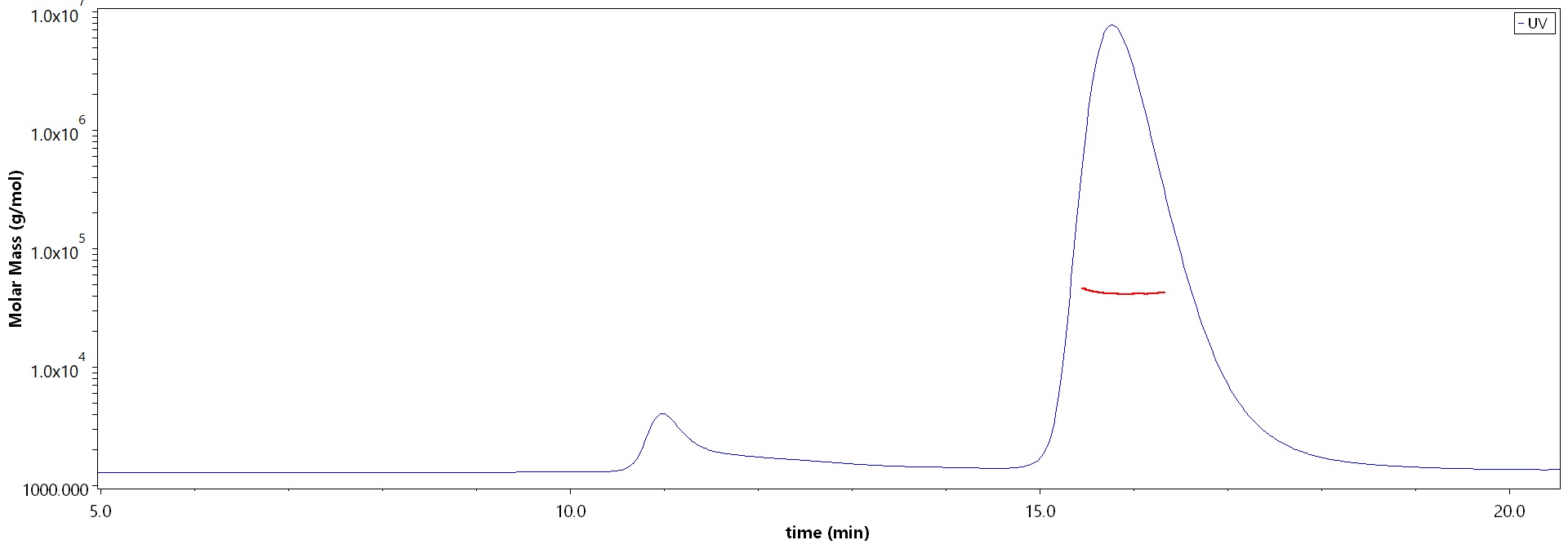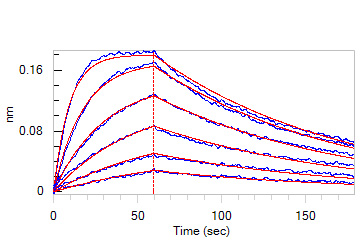
Leave message
Can’t find what you’re looking for?
Fill out this form to inquire about our custom protein services!
Inquire about our Custom Services >>

































 Limited Edition Golden Llama is here! Check out how you can get one.
Limited Edition Golden Llama is here! Check out how you can get one.  Limited Edition Golden Llama is here! Check out how you can get one.
Limited Edition Golden Llama is here! Check out how you can get one.
 Offering SPR-BLI Services - Proteins provided for free!
Offering SPR-BLI Services - Proteins provided for free!  Get your ComboX free sample to test now!
Get your ComboX free sample to test now!
 Time Limited Offer: Welcome Gift for New Customers !
Time Limited Offer: Welcome Gift for New Customers !  Shipping Price Reduction for EU Regions
Shipping Price Reduction for EU Regions
> Insights > Nature: CAS and ACROBiosystems found a potent Nab for all VOCs and future mutants Recently, CAS and ACROBiosystems published new research findings about Omicron, entitled “Memory B cell repertoire from triple vaccines against diverse SARS-CoV-2 variants” on Nature. A potent broad-spectrum neutralizing antibody for all VOC mutants was identified from serological samples of three-dose inactivated vaccine recipients, which might be a possible solution for Omicron and future mutants.
As a partner to IBP, ACRO were responsible for the BLI assay and provided core research tools, including WT and all VOCs antigens as well as inhibitor screening kit.
The study first tested neutralizing antibody titers of serum samples of Sinovac‘s vaccine recipients against WT, Delta and Omicron in live virus assays. The results showed that GMT NT50 of serum samples after two doses of vaccination was only 33 for WT, 6 for Delta (5.5-fold decrease) and barely zero for Omicron. These outcomes indicate non effectiveness of serum antibodies against Omicron after two doses of vaccination of inactivated vaccines. In contrast, receiving three doses of vaccination boosted the level of neutralization against WT, Delta and Omicron to a higher level, with the Omicron response still being the weakest (Figure 1).

Figure 1. Neutralization of serological antibodies (post 2-dose vs. 3-dose) against WT, Delta and Omicron
The researchers then isolated memory B cells from human peripheral blood mononuclear cells (PBMC) from the vaccinated individuals vaccinated with 3 doses of inactivated vaccines. Following this, they obtained the sequences of variable regions of the heavy and light antibody chains by gene sequencing. The antibodies were recombinantly expressed in vitro and analyzed for binding epitopes. Among the obtained antibodies, 163 were found to bind viral RBD, 100 to NTD, and 51 to S2 subunit. Of the RBD-binding antibodies, 31 can potently neutralize WT and all VOC variants (Alpha, Beta, Gamma, Delta, Omicron) in pseudovirus and live virus assays, and 30 of them can effectively block the ACE2-RBD interaction (Figure 2).

Figure 2. Isolation of potent neutralizing antibodies from PBMCs in 3-dose inactivated vaccine recipients.
Few antibodies-maintained neutralization against Omicron. According to previous studies, the half inhibitory concentrations (IC50) of GSK/Vir's VIR-7831 and Singlomics' DXP-604 against Omicron pseudovirus were 0.27ug/ml and 0.16ug/ml, respectively. Among the 31 broad-spectrum antibodies obtained in this study, 13 had IC50 against Omicron of less than 0.02ug/ml, which was 10-40 times the neutralizing activity of VIR-7831 and DXP-604, indicating that these antibodies have strong neutralization against Omicron and are promising to be used for the prevention and treatment of Omicron infection.
Based on the team’s previous structural research that divided the neutralizing antibodies into classes I-VI by differential binding epitopes, the broad-spectrum neutralizing antibodies identified in this study can be classified into class I, II and IV as tested by competitive ELISA. The researchers selected 4 antibodies representative for structural analysis and here is what they found: XGv347 (class II antibody) and XGv289 (class IV antibody) had strong neutralizing activity against all VOCs; XGv282 (class IV antibody) has a very strong neutralizing activity against VOCs other than Omicron, with slightly compromised ability to neutralize Omicron; XGv265 (class IV antibody) has a very strong neutralizing activity against VOCs other than Omicron, with a significantly reduced neutralizing activity against Omicron.
The researchers further analyzed the three-dimensional structure of the complex formed between the antibody Fab region and the Omicron spike trimer protein by cryo-electron microscopy. It was found that the Fab of XGv347 binds to the antigen in three states:
1) 3 Fabs simultaneously bind to 3 RBDs in the “down” conformation;
2) 2 Fabs simultaneously bind to 2 RBDs in the “up” conformation;
3) 2 Fabs bind to 2 RBDs one in an “up” and the other in a “down” conformation, respectively.
Different from XGv347, the Fab of XGv289, XGv282, and XGv265 each bind to the antigen in only one state (Figure 3)
3 XGv289 Fabs bind to 2 “up” and 1 “down” RBDs
3 XGv282 Fabs bind to 1 “up” and 2 “down” RBDs
2 XGv265 Fabs bind to 1 “up” and 1 “down” RBD

Figure 3. Different RBD binding patterns of the four selected neutralizing antibodies from different classes.
It was shown that there is a significant overlap between XGv347 binding sites and the ACE2 binding sites on RBD. In addition, the binding pattern of XGv347 shares an extent of similarity with the previously reported pan-coronavirus neutralizing antibodies A23-58.1 and S2K146, indicating the potential of this class of antibodies in neutralizing Omicron and other potentially emerging mutants. Examination of XGv289, XGv282, and XGv265 showed that their binding sites are similar to REGN10987, DH1047, REG-812, and their common reduction in neutralization might be impacted by the N440K and G446S mutations that appeared in Omicron (Figure 4).

Figure 4. Binding epitopes of the four selected antibodies in comparison with licensed mAbs.
It is worth noting that the binding affinity between XGv282 and Omicron RBD decreased just 5- fold, but its neutralizing effect decreased almost 40-fold. In contrast, XGv347 had a 40-fold decrease in affinity with Omicron RBD yet maintained a strong level of neutralization. This means that binding epitope matters more than binding affinity in determining antibody neutralization.
In the challenge test in BALB/c mice, a single injection of XGv282 antibody can reduce the viral RNA load of the host lung tissues by about 1000 times. A single injection of XGv347, XGv289, XGv282, XGv265, XGv052 and combinatorial injection of XGv052/XGv289, XGv282/XGv347 almost completely cleared the virus, and no obvious damage was observed in histopathological sections (Figure 5).

Figure 5. Neutralizing antibodies provide strong protection against viral infection in BALB/c mice.
In the challenge test of human ACE2 transgenic mice, injection of XGv347 could completely clear the viral RNA load caused by Omicron infection in lungs with no obvious damage was observed in histopathological sections (Figure 6).

Figure 6. XGv347 provides strong protection against Omicron infection in human ACE2 transgenic mice.
Conclusion
The neutralizing antibodies screened and identified in this study can broadly neutralize WT and all VOC strains, having a good protective effect in mice infected with Beta and Omicron. Antibodies that recognize epitopes in the same region were characterized with structural analysis, and different classes of antibodies can be used as a cocktail therapy for the prevention and treatment of circulating and emerging strains of COVID-19. In addition, analysis of antigenic epitopes recognized by broad-spectrum potent neutralizing antibodies also provides a theoretical basis for the design of a new generation of vaccines.
Core reagents in this research
| Lineage | Cat.No. | Molecule | Product description |
|---|---|---|---|
| Wild Type | SPD-C52H3 | Spike RBD | SARS-CoV-2 (COVID-19) S protein RBD, His Tag (MALS verified) |
| Alpha | SPD-C52Hn | Spike RBD | SARS-CoV-2 (COVID-19) S protein RBD (N501Y), His Tag (MALS verified) |
| Beta | SPD-C52Hp | Spike RBD | SARS-CoV-2 (COVID-19) S protein RBD (K417N, E484K, N501Y), His Tag (MALS verified) |
| Gamma | SPD-C52Hr | Spike RBD | SARS-CoV-2 S protein RBD (K417T, E484K, N501Y), His Tag (MALS verified) |
| Delta | SPD-C52Hh | Spike RBD | SARS-CoV-2 Spike RBD (L452R, T478K), His Tag (MALS verified) |
| Omicron | SPD-C522e | Spike RBD | SARS-CoV-2 Spike RBD, His Tag (B.1.1.529/Omicron) |
| Omicron | EP-115 | Inhibitor Screening Kit | SARS-CoV-2 (B.1.1.529) Inhibitor Screening Kit (Spike RBD) |
Assay data

The purity of SARS-CoV-2 Spike RBD, His Tag (B.1.1.529/Omicron) (Cat. No. SPD-C522e) is more than 90% and the molecular weight of this protein is around 33-48 kDa verified by SEC-MALS.

Loaded Human ACE2, Fc Tag (Cat. No. AC2-H5257) on Protein A Biosensor, can bind SARS-CoV-2 Spike RBD, His Tag (B.1.1.529/Omicron) (MALS verified) (Cat. No. SPD-C522e) with an affinity constant of 11.4 nM as determined in BLI assay (ForteBio Octet Red96e).
This web search service is supported by Google Inc.







